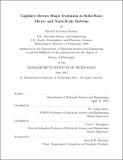| dc.contributor.advisor | W. Craig Carter and Carl V. Thompson. | en_US |
| dc.contributor.author | Zucker, Rachel V. (Rachel Victoria) | en_US |
| dc.contributor.other | Massachusetts Institute of Technology. Department of Materials Science and Engineering. | en_US |
| dc.date.accessioned | 2015-09-17T17:43:30Z | |
| dc.date.available | 2015-09-17T17:43:30Z | |
| dc.date.copyright | 2015 | en_US |
| dc.date.issued | 2015 | en_US |
| dc.identifier.uri | http://hdl.handle.net/1721.1/98575 | |
| dc.description | Thesis: Ph. D., Massachusetts Institute of Technology, Department of Materials Science and Engineering, 2015. | en_US |
| dc.description | This electronic version was submitted by the student author. The certified thesis is available in the Institute Archives and Special Collections. | en_US |
| dc.description | Cataloged from student-submitted PDF version of thesis. | en_US |
| dc.description | Includes bibliographical references (pages 185-192). | en_US |
| dc.description.abstract | Thin films are the fundamental building blocks of many micro- and nano-scale devices. However, their high surface-area-to-volume ratio makes them unstable due to excess surface free energy. Capillarity drives a process known as dewetting, during which holes form, the film edges retract, and a thickened rim of material accumulates at the edges. Various shape instabilities can occur on the film edge, resulting in complicated morphologies and break-up of the film into isolated particles. Dewetting occurs in the solid state by surface self-diffusion. In this work, a variety of models are presented to gain insights into the mechanisms that control the shape evolution of thin films. A combination of thermodynamic study, stability analyses, analytical models, explicit interface-tracking simulations, and phase-field simulations reveal the underlying driving forces and mass flows, explain observed morphologies and instabilities, and offer insights into how to manipulate the final structure. These pathways to control dewetting are applicable in two areas: to design micro- and nano-scale devices that are resistant to thermal degradation, and to use dewetting as a new patterning method to generate stable, complex, small-scale geometries. | en_US |
| dc.description.statementofresponsibility | by Rachel Victoria Zucker. | en_US |
| dc.format.extent | 192 pages | en_US |
| dc.language.iso | eng | en_US |
| dc.publisher | Massachusetts Institute of Technology | en_US |
| dc.rights | M.I.T. theses are protected by copyright. They may be viewed from this source for any purpose, but reproduction or distribution in any format is prohibited without written permission. See provided URL for inquiries about permission. | en_US |
| dc.rights.uri | http://dspace.mit.edu/handle/1721.1/7582 | en_US |
| dc.subject | Materials Science and Engineering. | en_US |
| dc.title | Capillary-driven shape evolution in solid-state micro- and nano-scale systems | en_US |
| dc.type | Thesis | en_US |
| dc.description.degree | Ph. D. | en_US |
| dc.contributor.department | Massachusetts Institute of Technology. Department of Materials Science and Engineering | |
| dc.identifier.oclc | 920881415 | en_US |
